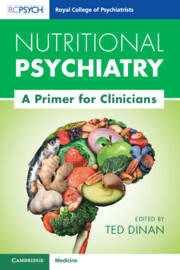Book contents
- Nutritional Psychiatry
- Nutritional Psychiatry
- Copyright page
- Contents
- Contributors
- Preface
- Chapter 1 Basic Principles of Nutrition
- Chapter 2 Diet and the Microbiome–Gut–Brain Axis
- Chapter 3 The Mediterranean Diet and Mental Health
- Chapter 4 Psychobiotics and Fermented Foods
- Chapter 5 Diet Interventions for Anxiety and Depression
- Chapter 6 Schizophrenia, Microbiota and Nutrition
- Chapter 7 Recognising the Importance of Nutrition for Child and Adolescent Mental Health
- Chapter 8 Old Age and Nutrition
- Chapter 9 Broad-Spectrum Micronutrients and Mental Health
- Chapter 10 Epigenetics
- Index
- References
Chapter 4 - Psychobiotics and Fermented Foods
Published online by Cambridge University Press: 17 August 2023
- Nutritional Psychiatry
- Nutritional Psychiatry
- Copyright page
- Contents
- Contributors
- Preface
- Chapter 1 Basic Principles of Nutrition
- Chapter 2 Diet and the Microbiome–Gut–Brain Axis
- Chapter 3 The Mediterranean Diet and Mental Health
- Chapter 4 Psychobiotics and Fermented Foods
- Chapter 5 Diet Interventions for Anxiety and Depression
- Chapter 6 Schizophrenia, Microbiota and Nutrition
- Chapter 7 Recognising the Importance of Nutrition for Child and Adolescent Mental Health
- Chapter 8 Old Age and Nutrition
- Chapter 9 Broad-Spectrum Micronutrients and Mental Health
- Chapter 10 Epigenetics
- Index
- References
Summary
Psychobiotics are bacteria that have a positive mental health benefit when ingested in adequate amounts. They act through the brain–gut–microbiota axis which is a bidirectional communication system linking gut microbes and the brain. Until relatively recently, gut microbes were viewed as commensal with no major impact on brain function. It is now clear that gut microbes produce an array of molecules which are essential for normal brain function, for example short-chain fatty acids. Over 1,000 strains of bacteria have been identified in the human gut and there is increasing evidence to support the view that psychiatric illnesses are associated with a gut dysbiosis. It is within this context that the field of psychobiotic research has emerged. Given the novel state of the field, it is not surprising that there are far more animal than human studies in the literature. However, there is growing evidence that some psychobiotics can play a role in managing stress-related disorders such as anxiety, depression and irritable bowel syndrome. So far, the major focus of psychobiotic research has been on Lactobacilli and Bifidobacteria, but there is potential to use a far broader range of bacteria. Psychobiotics have the ability to influence the core stress axis, namely the hypothalamic–pituitary–adrenal axis, reduce inflammatory responses, elevate brain trophic factors and impact positively on a ‘leaky gut’. Overall, the field represents a paradigm shift in psychiatry.
- Type
- Chapter
- Information
- Nutritional PsychiatryA Primer for Clinicians, pp. 55 - 71Publisher: Cambridge University PressPrint publication year: 2023



